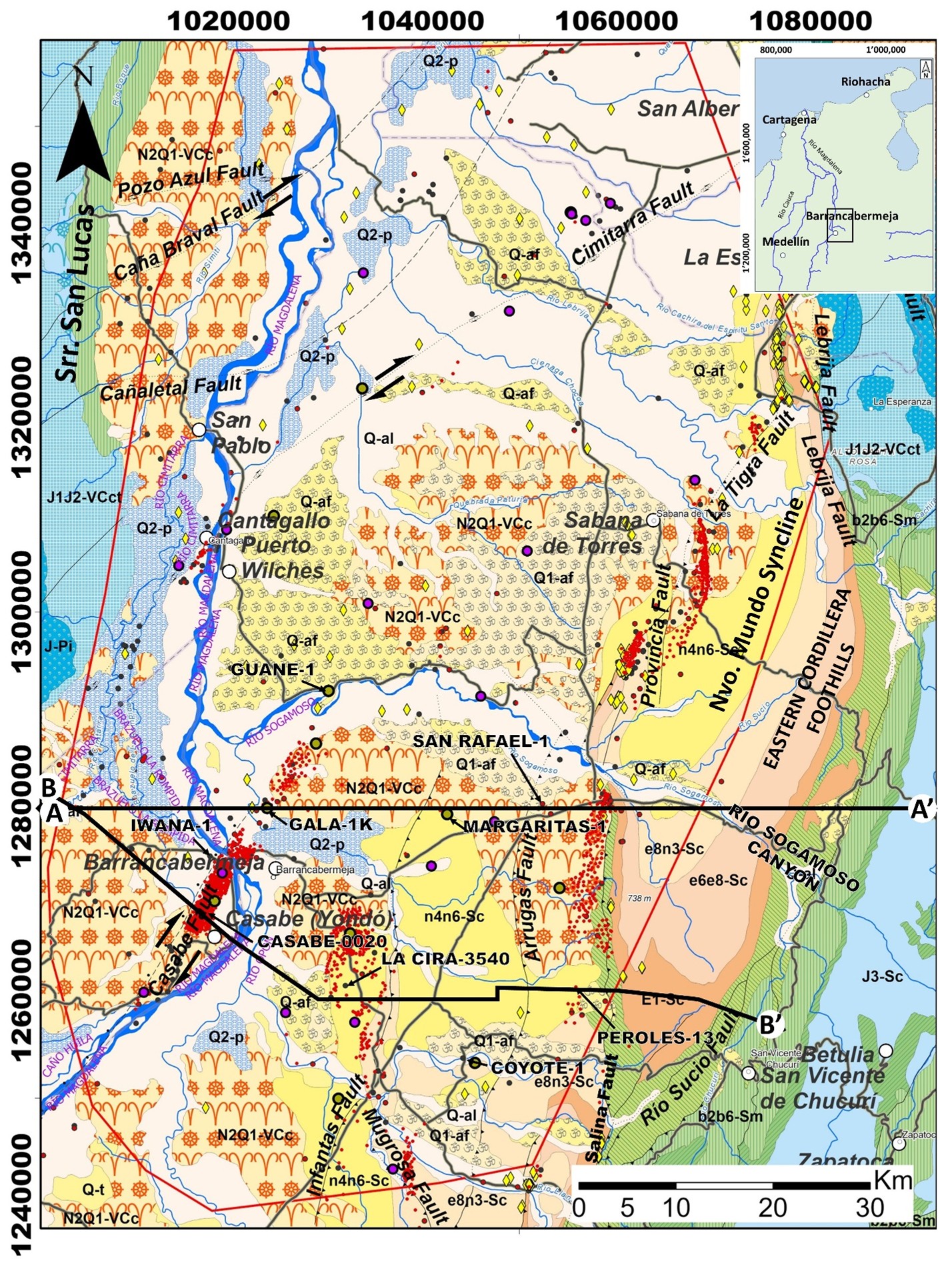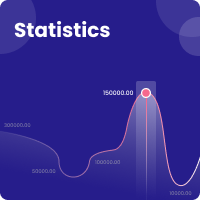Assessment of CO2 storage capacity and high-quality corridors for potential CCS projects in the central part of the VMM basin, Colombia
Abstract
There are numerous industrial processes and energy generators that emit CO2 into the atmosphere, which are still in an incipient state of technological transition for their reduction. A global expanding alternative involves storing CO2 for long periods (> 1,000 years), in geological environments such as saline aquifers. Thus, studies on a semi-regional scale are fundamental to reduce the uncertainty regarding location of sites with the best storage capacities and high Chance of Successful. The use of Forward Stratigraphic Modeling (FSM) workflows to populate static models with properties is a time-versatile tool to evaluate the prospectivity of subsurface resources over large areas, as required for CO2 storage. These workflows, coupled to Common Risk Segment Analysis, have been applied in a basin with a long history of O&G exploration and production, the Middle Magdalena Valley basin in Colombia, proving their effectiveness in the selection of areas along prospective corridors to store CO2, in Mesozoic and Cenozoic formations. Preliminary estimates suggest that the Meso-Cenozoic formations in this part of the basin may reach a Theoretical CO2 Storage Capacity close to 830 GTon CO2 and an Effective CO2 Storage Capacity of 293 GTon CO2.
References
Afanador, D. O., & Velandia, F. (2021). Late Jurassic syn-extensional sedimentary deposition and Cenozoic basin inversion as recorded in The Girón Formation, northern Andes of Colombia. Andean Geology, 48(2), 237-266. https://doi.org/10.5027/andgeoV48n2-3264
Aguilera, R., Sotelo, V., Burgos, C., Arce, C., Gómez, C., Mojica, J., ... & Osorno, J. (2010). Organic geochemistry atlas of Colombia. Second Edition Earth Sciences Research Journal, 14, Special Edition, 164 p. 61-77. https://www.anh.gov.co/documents/14/Atlas_Geoquimico_2010.pdf
Aktouf, A., & Bentellis, A. (2016). CO2-storage assessment and effective capacity in Algeria. SpringerPlus, 5(1), 1038. https://doi.org/10.1186/s40064-016-2682-7
Alfaro, C., Alvarado, I., Quintero, W., Hamza, V., Vargas, C., & Briceño, L. (2009). Mapa preliminar de gradientes geotérmicos de Colombia. In XII Congreso Colombiano de Geología (pp. 1-24). https://www.researchgate.net/publication/317497383_Evaluacion_termal_de_6_pozos_de_la_parte_central_de_la_cordillera_oriental_Colombia_a_partir_de_paleogeotermas_implicaciones_sobre_la_historia_termica_y_los_hidrocarburos
Alfaro, C., Alvarado, I., & Manrique, A. (2015). Heat flow evaluation at Eastern Llanos sedimentary basin, Colombia. In World Geothermal Congress (Vol. 34, pp. 1-9). https://www.semanticscholar.org/paper/Heat-Flow-Evaluation-at-Eastern-Llanos-Sedimentary-Alfaro-Alvarado/a41fcfd55678e8b2b3c8a43ff406bc94616f45bf/figure/0
Asadzadeh, S., Arango, I. R. P., & de Souza Filho, C. R. (2022). Mapping natural oil seeps in the Middle Magdalena Basin (Colombia) using WorldView-3 satellite data. AAPG Bulletin, 106(4), 783-801. https://doi.org/10.1306/09282120069
Avila, N. A. (2010). Aplicación de datos de afloramiento en el modelo de facies de las formaciones Colorado y Mugrosa en el campo Casabe sur en la cuenca del Valle Medio del Magdalena. [Tesis de pregrado, Universidad Industrial de Santander].. https://noesis.uis.edu.co/items/30f4b482-284f-4e55-89f3-3a9275c0b6c5
Bachu, S. (2008). Comparison between methodologies recommended for estimation of CO2 storage capacity in geological media. In Carbon sequestration leadership forum, Phase III Report. https://citeseerx.ist.psu.edu/document?repid=rep1&type=pdf&doi=a745711090b05956f9c122c462fc6391b31e91b7
Bachu, S. (2001). Geological sequestration of anthropogenic carbon dioxide: applicability and current issues. In L. C. Gerhard, W. E. Harrison, & B. M. Hanson (Eds.), Geological perspectives of global climate change. American Association of Petroleum Geologists. https://doi.org/10.1306/St47737C16
Bachu, S. (2003). Screening and ranking of sedimentary basins for sequestration of CO2 in geological media in response to climate change. Environmental Geology, 44(3), 277-289. https://doi.org/10.1007/s00254-003-0762-9
Barlow, H., Shahi, S., & Kearns, D. (2025). Advancements in CCS technologies and costs. https://www.globalccsinstitute.com/wp-content/uploads/2025/01/Advancements-in-CCS-Technologies-and-Costs-Report-2025.pdf
Barrero, D., Pardo, A., Vargas, C. A., & Martínez, J. F. (2007). Colombian sedimentary basins: Nomenclature, boundaries and petroleum geology, a new proposal. In J. Letouzey (Ed.), Petroleum and tectonics in mobile belts (pp. 81–100). Agencia Nacional de Hidrocarburos. https://www.researchgate.net/publication/326424170_Colombian_Sedimentary_Basins
Bayona, G. (2018). El inicio de la emergencia en los Andes del norte: una perspectiva a partir del registro tectónico-sedimentológico del Coniaciano al Paleoceno. Revista de la Academia Colombiana de Ciencias Exactas, Físicas y Naturales, 42(165), 364-378. https://doi.org/10.18257/raccefyn.632
Beltran, E. C. (2012). Estudio sedimentológico comparativo entre las formaciones Mugrosa y Colorado; y modelamiento de los niveles de las arenas A2 de la Formación Colorado en el campo Casabe en la cuenca del Valle Medio del Magdalena, Colombia [Tesis de pregrado, Universidad Industrial de Santander]. https://noesis.uis.edu.co/items/c857f670-4328-40ef-8612-bcaaebd8f982
Benson, S. M., & Cole, D. R. (2008). CO2 sequestration in deep sedimentary formations. Elements, 4(5), 325-331. https://doi.org/10.2113/gselements.4.5.325
Bui, M., Adjiman, C. S., Bardow, A., Anthony, E. J., Boston, A., Brown, S., Fennell, P. S., Fuss, S., Galindo, A., Hackett, L. A., Hallett, J. P., Herzog, H. J., Jackson, G., Kemper, J., Krevor, S., Maitland, G. C., Matuszewski, M., Metcalfe, I. S., Petit, C., ... Mac Dowell, N. (2018). Carbon capture and storage (CCS): the way forward. Energy & Environmental Science, 11(5), 1062-1176. https://doi.org/10.1039/C7EE02342A
Bump, A. P., Hovorka, S. D., & Meckel, T. A. (2021). Common risk segment mapping: Streamlining exploration for carbon storage sites, with application to coastal Texas and Louisiana. International Journal of Greenhouse Gas Control, 111, 103457. https://doi.org/10.1016/j.ijggc.2021.103457
Busch, A., & Müller, N. (2011). Determining CO2/brine relative permeability and capillary threshold pressures for reservoir rocks and caprocks: Recommendations for development of standard laboratory protocols. Energy Procedia, 4, 6053-6060. https://doi.org/10.1016/j.egypro.2011.02.610
Caballero, V. M., Rodríguez, G., Naranjo, J. F., Mora, A., & De La Parra, F. (2020). From facies analysis, stratigraphic surfaces, and depositional sequences to stratigraphic traps in the Eocene–Oligocene record of the southern Llanos Basin and northern Magdalena Basin. The geology of Colombia, 3, 283-330. https://www.researchgate.net/profile/Victor-Caballero-3/publication/342328390_From_Facies_Analysis_Stratigraphic_Surfaces_and_Depositional_Sequences_to_Stratigraphic_Traps_in_the_Eocene_-_Oligocene_Record_of_the_Southern_Llanos_Basin_and_Northern_Magdalena_Basin/links/5eed6a05458515814a6ecda3/From-Facies-Analysis-Stratigraphic-Surfaces-and-Depositional-Sequences-to-Stratigraphic-Traps-in-the-Eocene-Oligocene-Record-of-the-Southern-Llanos-Basin-and-Northern-Magdalena-Basin.pdf
Caballero, V., Parra, M., Mora, A., López, C., Rojas, L. E., & Quintero, I. (2013). Factors controlling selective abandonment and reactivation in thick-skin orogens: A case study in the Magdalena Valley, Colombia. https://doi.org/10.1144/SP377.4
Caballero, V., Parra, M., & Mora Bohorquez, A. R. (2010). Levantamiento de la Cordillera Oriental de Colombia durante el Eoceno tardío-Oligoceno temprano: proveniencia sedimentaria en el Sinclinal de Nuevo Mundo, cuenca Valle Medio del Magdalena. Boletín de geología, 32(1), 45-77. http://www.scielo.org.co/scielo.php?pid=S0120-02832010000100003&script=sci_arttext
Cabello, P., Lopez, C., Gamba, N., Dussán, M. I., Torres, E., Ballesteros-Torres, C. I., ... & Ramos, E. (2018). An integrated approach to define new plays in mature oil basins: The example from the Middle Magdalena Valley basin (Colombia). AAPG Bulletin, 102(11), 2201-2238. https://doi.org/10.1306/03291816528
Cáceres, C., F. Cediel, and F. Etayo-Serna. (2003). Guía introductoria de la distribución de facies sedimentarias de Colombia, Mapas de distribución de facies sedimentarias y armazón tectónico de Colombia a través del Proterozoico y del Fanerozoico. INGEOMINAS. https://catalogo.sgc.gov.co/cgi-bin/koha/opac-detail.pl?biblionumber=46163
Cardoso, R. A., & Hamza, V. M. (2014). Heat flow in the Campos sedimentary basin and thermal history of the continental margin of southeast Brazil. International Scholarly Research Notices, 2014(1), 384752. https://doi.org/10.1155/2014/384752
Carman, P. C. (1939). Permeability of saturated sands, soils and clays. The Journal of Agricultural Science, 29(2), 262-273.. https://doi.org/10.1017/S0021859600051789
Clavijo, J., Mantilla, L., Pinto, J., Bernal, L., & Pérez, A. (2008). Evolución geológica de la Serranía de San Lucas, norte del Valle Medio del Magdalena y noroeste de la Cordillera Oriental. Boletín de Geología, 30(1), 45-62. http://www.scielo.org.co/scielo.php?pid=S0120-02832008000100004&script=sci_arttext
Cohen, K. M., Finney, S. C., Gibbard, P. L., & Fan, J. X. (2013). The ICS international chronostratigraphic chart. Episodes, 36(3), 199-204. . https://doi.org/10.18814/epiiugs/2013/v36i3/002
Cooperation, A. P. E. (2005). CO2 storage prospectivity of selected sedimentary basins in the region of China and South East Asia. APEC Energy Work Group EWG Project. https://www.apec.org/Publications/2005/06/CO2-Storage-Prospectivity-of-Selected-Sedimentary-Basins-in-the-Region-of-China-and-South-East-Asia
Cooper, M. A., Addison, F. T., Alvarez, R., Hayward, A. B., Howe, S., Pulham, A. J., & Taborda, A. (1995). Basin development and tectonic history of the Llanos Basin, Colombia. https://doi.org/10.1306/M62593C35
CSA Group. (2008). Assessment of the Potential for Geological Storage of CO2 for the Island of Ireland. Sustainable Energy Ireland. https://www.seai.ie/sites/default/files/publications/Assessment-of-the-Potential-for-Geological-Storage-of-CO2-for-the-Island-of-Ireland.pdf
Duwiquet, H., Arbaret, L., Guillou-Frottier, L., Heap, M. J., & Bellanger, M. (2019). On the geothermal potential of crustal fault zones: a case study from the Pontgibaud area (French Massif Central, France). Geothermal Energy, 7, 1-29. https://doi.org/10.1186/s40517-019-0150-7
Ellett, K., Zhang, Q., Medina, C., Rupp, J., Wang, G., & Carr, T. (2013). Uncertainty in regional-scale evaluation of CO2 geologic storage resources—Comparison of the Illinois Basin (USA) and the Ordos Basin (China). Energy Procedia, 37, 5151-5159. https://doi.org/10.1016/j.egypro.2013.06.430
Etayo-Serna, F. (2019). Basin development and tectonic history of the Middle Magdalena Valley. Estudios geológicos y paleontológicos sobre el Cretácico en la región del embalse del río Sogamoso, Valle Medio del Magdalena, 413-423.
Etayo-Serna, F., Arenas, D. M., Sánchez, G. M., Melo, R. T., & Ospitia, G. G. (2020). Estudios geológicos y paleontológicos sobre el Cretácico en la región del embalse del río Sogamoso, Valle Medio del Magdalena. https://libros.sgc.gov.co/index.php/editorial/catalog/book/24
Energy, P. B. D. (2020). Global Storage Resource Assessment–2019 Update. https://www.globalccsinstitute.com/resources/publications-reports-research/global-storage-resource-assessment-2019-update/
Geological Survey (US), & Paris, G. (2000). Map and database of Quaternary faults and folds in Colombia and its offshore regions (pp. 1-61). US Geological Survey. https://doi.org/10.3133/ofr00284
Gómez, J., Montes, N. E., Nivia, A., & Diederix, H. (2015). Atlas geológico de Colombia 2015. Escala, 1(500), 000. https://www.researchgate.net/publication/309533584_Plancha_5-06_del_Atlas_Geologico_de_Colombia_2015
González, R. E., Suárez, C. O., Higuera, I. C., & Rojas, L. E. (2020). Alternative workflow for three-dimensional basin modeling in areas of structural complexity: Case study from the Middle Magdalena Valley, Colombia. AAPG Bulletin, 104(1), 1-19. https://doi.org/10.1306/0415191612917185
Granjeon, D., & Joseph, P. (1999). Concepts and applications of a 3-D multiple lithology, diffusive model in stratigraphic modeling. https://doi.org/10.2110/pec.99.62.0197
Guerrero, J., Montes, L., Jaillard, E., & Kammer, A. (2021). Seismic interpretation of the Cretaceous unconformities and sequences in the Middle Magdalena Valley and the western margin of the Eastern Cordillera, Colombia. Comptes Rendus. Géoscience, 353(1), 155-172. https://doi.org/10.5802/crgeos.47
Haq, B. U., Hardenbol, J., Vail, P. R., Stover, L. E., Colin, J. P., Ioannides, N. S., ... & Morgan, B. E. (1988). Mesozoic and Cenozoic chronostratigraphy and cycles of sea-level change. https://doi.org/10.2110/pec.88.01.0071
Hasbollah, D. Z. A., & Junin, R. (2017). Assessment of geological CO2 storage potential in central Luconia province. International Journal of Advanced and Applied Sciences, 4(2), 44-48. https://doi.org/10.21833/ijaas.2017.02.008
Hicks, N., Davids, S., Beck, B., & Green, A. (2014). Investigation of CO2 storage potential of the Durban Basin in South Africa. Energy Procedia, 63, 5200-5210. https://doi.org/10.1016/j.egypro.2014.11.551
Horton, B. K., Anderson, V. J., Caballero, V., Saylor, J. E., Nie, J., Parra, M., & Mora, A. (2015). Application of detrital zircon U-Pb geochronology to surface and subsurface correlations of provenance, paleodrainage, and tectonics of the Middle Magdalena Valley Basin of Colombia. Geosphere, 11(6), 1790-1811. https://doi.org/10.1130/GES01251.1
Horton, B. K., Parra, M., & Mora, A. (2020). Construction of the Eastern Cordillera of Colombia: Insights from the sedimentary record. The geology of Colombia, 3, ca-3. https://repositorio.usp.br/directbitstream/1e119c88-9a34-4eeb-bf2c-50c7b84727d1/3119630.pdf
Ibañez–Mejia, M., Gómez, J., & Mateus–Zabala, D. (2020). The Putumayo orogen of Amazonia: a synthesis. The geology of Colombia, Volume 1 Proterozoic-Paleozoic. https://www2.sgc.gov.co/LibroGeologiaColombia/tgc/sgcpubesp35201906.pdf
INGEOMINAS-UIS. (2006). Cartografía geológica de 9.600 km2 de la serranía de San Lucas: Planchas 55 (El Banco), 64 (Barranco de Loba), 85 (Simití) y 96 (Bocas del Rosario). Aporte a su evolución geológica. Memoria explicativa de la Plancha 96-Bocas del Rosario. https://miig.sgc.gov.co/Paginas/Resultados.aspx?k=230082105010024369000000000
International Energy Agency. CO2 Emissions in 2022. IEA Publications, 2023, 19. https://www.iea.org/reports/co2-emissions-in-2022
Javaid, A., Arshed, N., Munir, M., Amani Zakaria, Z., Alamri, F. S., Abd El-Wahed Khalifa, H., & Hanif, U. (2022). Econometric assessment of institutional quality in mitigating global climate-change risk. Sustainability, 14(2), 669. https://doi.org/10.3390/su14020669
Kozeny, J. (1927). Ueber kapillare leitung des wassers im boden. Sitzungsberichte der Akademie der Wissenschaften in Wien, 136, 271. https://cir.nii.ac.jp/crid/1370285708268135431.
La Croix, A., He, J., Wang, J., & Gonzalez, S. (2018). Geologically-realistic facies distribution in static reservoir models for CO2 sequestration: from core to wireline logs to grid cells. In 14th Greenhouse Gas Control Technologies Conference Melbourne (pp. 21-26). https://doi.org/10.2139/ssrn.3366017
López, E. (2004). Deep crust models of Colombia. República de Colombia. Ministerio de Minas y Energía. Instituto Colombiano de Geología y Minería. INGEOMINAS. Bogotá DC. 43p, 2. https://catalogo.sgc.gov.co/cgi-bin/koha/opac-detail.pl?biblionumber=48418
López-Ramos, E., Rincón-Martínez, D., Moreno, N., & Gómez, P. D. (2021). Mass balance of Neogene sediments in the Colombia Basin relationship with the evolution of the Magdalena and Cauca River basins. CT&F-Ciencia, Tecnología y Futuro, 11(1), 65-96. https://doi.org/10.29047/01225383.297
Ma, J., Li, L., Wang, H., Du, Y., Ma, J., Zhang, X., & Wang, Z. (2022). Carbon capture and storage: history and the road ahead. Engineering, 14, 33-43. https://doi.org/10.1016/j.eng.2021.11.024
Madero, H. D., Rueda, J. P., Ortiz, A., & Colegial, J. D. (2010). Análisis estratigráfico para las arenas de la Formacion Mugrosa en área piloto implicaciones paleogeográficas. Boletín de Geología, 32(1), 27-44. http://www.scielo.org.co/scielo.php?pid=S0120-02832010000100002&script=sci_arttext
Milesi, G., Monié, P., Münch, P., Soliva, R., Taillefer, A., Bruguier, O., ... & Martin, C. (2020). Tracking geothermal anomalies along a crustal fault using (U-Th)/He apatite thermochronology and rare-earth element (REE) analyses: The example of the Têt fault (Pyrenees, France). Solid Earth, 11(5), 1747-1771. https://doi.org/10.5194/se-11-1747-2020
Montes, C., Silva, C. A., Bayona, G. A., Villamil, R., Stiles, E., Rodriguez-Corcho, A. F., ... & von Quadt, A. (2021). A middle to late Miocene trans-Andean portal: Geologic record in the Tatacoa Desert. Frontiers in Earth Science, 8, 587022. https://doi.org/10.3389/feart.2020.587022
Mora, A., Reyes-Harker, A., Rodriguez, G., Tesón, E., Ramirez-Arias, J. C., Parra, M., ... & Stockli, D. F. (2013). Inversion tectonics under increasing rates of shortening and sedimentation: Cenozoic example from the Eastern Cordillera of Colombia. https://doi.org/10.1144/SP377.17
Morales, L. G. (1958). General geology and oil occurrences of Middle Magdalena Valley, Colombia. https://catalogo.sgc.gov.co/cgi-bin/koha/opac-detail.pl?biblionumber=72133
Moreno, G. (2019). Mapa geológico del cañón del río Sogamoso, en el sector Villanueva, Zapatoca, Betulia, departamento de Santander. In F. Etayo-Serna (Ed.), Estudios geológicos y paleontológicos sobre el Cretácico en la región del embalse del río Sogamoso, Valle Medio del Magdalena (pp. 391–412). Servicio Geológico Colombiano. https://docslib.org/download/5838191/mapa-geol%C3%B3gico-del-ca%C3%B1%C3%B3n-del-r%C3%ADo-sogamoso-en-el-sector-villanueva-zapatoca-betulia-departamento-de-santander-mapa-geol%C3%B3
Nakanishi, S., Mizuno, Y., Okumura, T., Miida, H., Shidahara, T., & Hiramatsu, S. I. (2009). Methodology of CO2 aquifer storage capacity assessment in Japan and overview of the project. Energy Procedia, 1(1), 2639-2646. https://doi.org/10.1016/j.egypro.2009.02.031
National Energy Technology Laboratory (NETL), & United States Department of Energy (USDOE). (2015). Carbon storage atlas (5th ed.). https://edx.netl.doe.gov/dataset/netl-carbon-storage-atlas-fifth-edition/resource/4f44abdf-0976-4251-8838-457c60e638ba
NETL;USDOE (2007)., Carbon Sequestration Atlas of the United States and Canada. Albany: USDOE. https://doi.org/10.1016/j.earscirev.2011.11.002
NETL (US), & United States. Office of Fossil Energy. (2008). Carbon sequestration atlas of the United States and Canada. National Energy Technology Laboratory. https://books.google.com/books?hl=es&lr=&id=TYsJ04mY6ogC&oi=fnd&pg=PA4&dq=USDOE,+OFE,+NETL.+%E2%80%9CCarbon+Sequestration+Atlas+of+the+United+State+and+Canada.%E2%80%9D+2008,+90.&ots=IqJy8mj3Wh&sig=fBtL1164cJU-HeIzXk8_TMAAqLQ
Nie, J., Horton, B. K., Saylor, J. E., Mora, A., Mange, M., Garzione, C. N., ... & Parra, M. (2012). Integrated provenance analysis of a convergent retroarc foreland system: U–Pb ages, heavy minerals, Nd isotopes, and sandstone compositions of the Middle Magdalena Valley basin, northern Andes, Colombia. Earth-Science Reviews, 110(1-4), 111-126. https://www.sciencedirect.com/science/article/pii/S0012825211001656 https://doi.org/10.1016/j.earscirev.2011.11.002
OECD/IEA. (2015). Storing CO2 through Enhanced Oil Recovery. Paris: IEA. https://www.iea.org/reports/storing-co2-through-enhanced-oil-recovery
Pastor-Chacón, A., Aguilera, R., Triana, J. L., Paez-Reyes, M., Cantisano, M., Bravo, L., ... & Fuenzalida, H. (2023). Sweet spot areas for shale oil and shale gas plays in the Upper Cretaceous rocks of the Middle Magdalena Valley, Colombia: insights from basin modeling. Frontiers in Earth Science, 11, 1146126.. https://doi.org/10.3389/feart.2023.1146126
Piraquive, A., Kammer, A., Gómez, C., Bernet, M., Muñoz-Rocha, J. A., Quintero, C. A., ... & Peña-Urueña, M. L. (2021). Middle-late Triassic metamorphism of the Guajira Arch-basement: Insights from zircon U–Pb and Lu–Hf systematics. Journal of South American Earth Sciences, 110, 103397. https://doi.org/10.1016/j.jsames.2021.103397
Restrepo-Pace, P. A., & Cediel, F. (2010). Northern South America basement tectonics and implications for paleocontinental reconstructions of the Americas. Journal of South American Earth Sciences, 29(4), 764-771. https://doi.org/10.1016/j.jsames.2010.06.002
Reyes, M., Kley, J., Mora, A., Bello-Palacios, D., Vargas, A. F., Carvajal-Torres, J., & Osorno, J. (2022). La Cira Basement-high; Middle Magdalena Valley Basin, Colombia. In Andean Structural Styles (pp. 207-219). Elsevier. https://doi.org/10.1016/B978-0-323-85175-6.00015-8
Rode, D. C., Anderson, J. J., Zhai, H., & Fischbeck, P. S. (2023). Six principles to guide large-scale carbon capture and storage development. Energy Research & Social Science, 103, 103214. https://doi.org/10.1016/j.erss.2023.103214
Rodríguez-García, G., Correa-Martínez, A. M., Zapata-Villada, J. P., & Obando-Erazo, G. (2019). Fragments of a Permian arc on the western margin of the Neoproterozoic basement of Colombia. The geology of Colombia, 1(Chapter 10). https://www.researchgate.net/profile/Gabriel-Garcia-4/publication/336068226_Fragments_of_a_Permian_Arc_on_the_Western_Margin_of_the_Neoproterozoic_Basement_of_Colombia/links/5d8cb6df458515202b6a41f5/Fragments-of-a-Permian-Arc-on-the-Western-Margin-of-the-Neoproterozoic-Basement-of-Colombia.pdf
Rolon, L. F. (2004). Structural geometry of the Jura-Cretaceous rift of the Middle Magdalena Valley basin, Colombia. West Virginia University. https://search.proquest.com/openview/d2da18f457685ef5eb3d9415694e5513/1?pq-origsite=gscholar&cbl=18750&diss=y
Rutqvist, J., Wu, Y. S., Tsang, C. F., & Bodvarsson, G. (2002). A modeling approach for analysis of coupled multiphase fluid flow, heat transfer, and deformation in fractured porous rock. International Journal of Rock Mechanics and Mining Sciences, 39(4), 429-442. https://doi.org/10.1016/S1365-1609(02)00022-9
Rojas, L. S. (2002). Mesozoic rifting and Cenozoic basin inversion-History of the Eastern Cordilelra, Combian Andes. Inferences from tectonic models. https://research.vu.nl/en/publications/mesozoic-rifting-and-cenozoic-basin-inversion-history-of-the-east
Sheldon, H. A., Crombez, V., Poulet, T., Kelka, U., Kunzmann, M., & Kerrison, E. (2023). Realistic permeability distributions in faults and sediments: The key to predicting fluid flow in sedimentary basins. Basin Research, 35(6), 2118-2139. https://doi.org/10.1111/bre.12792
Silva, A., Mora, A., Caballero, V., Rodriguez, G., Ruiz, C., Moreno, N., ... & Quintero, I. (2013). Basin compartmentalization and drainage evolution during rift inversion: evidence from the Eastern Cordillera of Colombia. https://pubs.geoscienceworld.org/books/edited-volume/1859/chapter/107622195 https://doi.org/10.1144/SP377.15
Suárez Rueda, C. O. (2016). Arenas basales del Cretáceo inferior, potencial roca hidrocarburífera en la región central de la cuenca del Valle Medio del Magdalena, Colombia. Geología. https://repositorio.unal.edu.co/handle/unal/56512
Sun, L., Dou, H., Li, Z., Hu, Y., & Hao, X. (2018). Assessment of CO2 storage potential and carbon capture, utilization and storage prospect in China. Journal of the energy institute, 91(6), 970-977. https://doi.org/10.1016/j.joei.2017.08.002
Tasianas, A., & Koukouzas, N. (2016). CO2 storage capacity estimate in the lithology of the Mesohellenic Trough, Greece. Energy Procedia, 86, 334-341.https://doi.org/10.1016/j.egypro.2016.01.034
Vangkilde-Pedersen, T., K. L. Anthosen, and et al. (2009). "Assessing European capacity for geologial storage of carbon dioxide - the UE GeoCapacity project." Energy Procedia, 2663-2670. https://www.sciencedirect.com/science/article/pii/S1876610209006778 https://doi.org/10.1016/j.egypro.2009.02.034
Vargas Vargas, M. L. (2022). Geometría y evolución de la Falla Casabe en el Valle Medio del Magdalena, Colombia [Tesis doctoral, Universidad Nacional de Colombia]. https://repositorio.unal.edu.co/handle/unal/80847
Vásquez Parra, M. F. (2007). Mafic magmatism in the Eastern Cordillera and Putumayo Basin, Colombia: causes and consequences (Doctoral dissertation, Universität Potsdam). https://publishup.uni-potsdam.de/frontdoor/index/index/docId/1192
Villamil, T. (1998). Chronology, relative sea-level history and a new sequence stratigraphic model for basinal Cretaceous facies of Colombia. https://doi.org/10.2110/pec.98.58.0161
Xie, J., Zhang, K., Li, C., & Wang, Y. (2016). Preliminary study on the CO2 injectivity and storage capacity of low-permeability saline aquifers at Chenjiacun site in the Ordos Basin. International Journal of Greenhouse Gas Control, 52, 215-230. https://doi.org/10.1016/j.ijggc.2016.07.016
Yáñez, E., Ramírez, A., Núñez-López, V., Castillo, E., & Faaij, A. (2020). Exploring the potential of carbon capture and storage-enhanced oil recovery as a mitigation strategy in the Colombian oil industry. International Journal of Greenhouse Gas Control, 94, 102938. https://doi.org/10.1016/j.ijggc.2019.102938
Zuluaga, C. A., Pinilla, A., & Mann, P. (2015). Jurassic silicic volcanism and associated Continental-arc Basin in northwestern Colombia (southern boundary of the Caribbean plate). https://pubs.geoscienceworld.org/aapg/books/edited-volume/1509/chapter/107191661 https://doi.org/10.1306/13531934M1083640
Downloads

Copyright (c) 2025 CT&F - Ciencia, Tecnología y Futuro

This work is licensed under a Creative Commons Attribution-NonCommercial-ShareAlike 4.0 International License.

| Article metrics | |
|---|---|
| Abstract views | |
| Galley vies | |
| PDF Views | |
| HTML views | |
| Other views | |










